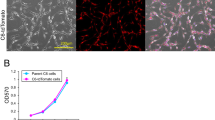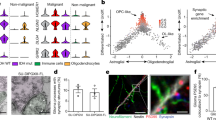Abstract
Seizures commonly occur in glioma patients, but their pathogenesis is poorly understood, in part due to a lack of valid and versatile experimental models. We have established a new model that enables comprehensive neuropathological and neurophysiological analysis on identical tissue preparations. Rat C6 glioma cells stably transfected with a green fluorescence protein (GFP) gene are transplanted into rat neocortex, giving rise to diffusely invading gliomas histologically resembling human glioblastomas. After 2 weeks, 500-µm-thick cerebral slices are prepared, stained with the voltage-sensitive dye RH795, and fluorescence changes associated with origin and spread of abnormal bioelectric activity upon washout of Mg2+ are detected by a 464-element photodiode array at a rate of 785 frames/s. GFP fluorescence promotes identification of tumor cells during electrophysiological experiments and in neuropathological analyses using frozen and paraffin-embedded tissue sections. By performing subsequent histological analysis of the slices examined neurophysiologically, origin and spread of abnormal activity can be correlated with structural and molecular (immunohistochemical) features. Specifically, we found that ictaform activity was initiated in cortical areas diffusely invaded by single tumor cells. This model is useful for further elucidating the electrophysiological, molecular and structural basis of glioma-associated epileptogenesis.


Similar content being viewed by others
References
Aronica E, Gorter JA, Jansen GH, Leenstra S, Yankaya B, Troost D (2001) Expression of connexin 43 and connexin 32 gap-junction proteins in epilepsy-associated brain tumors and in the perilesional epileptic cortex. Acta Neuropathol 101:449–459
Artelt P, Morelle C, Ausmeier M, Fitzek M, Hauser H (1988) Vectors for efficient expression in mammalian fibroblastoid, myeloid and lymphoid cells via transfection or infection. Gene 68:213–219
Beaumont A, Whittle IR (2000) The pathogenesis of tumour associated epilepsy. Acta Neurochir (Wien) 142:1–15
Duffau H, Capelle L, Lopes M, Bitar A, Sichez JP, Effenterre R van (2002) Medically intractable epilepsy from insular low-grade gliomas: Improvement after an extended lesionectomy. Acta Neurochir 144:563–573
Haglund MM, Berger MS, Kunkel DD, Franck JE, Ghatan S, Ojemann GA (1992) Changes in gamma-aminobutyric acid and somatostatin in epileptic cortex associated with low-grade gliomas. J Neurosurg 77:209–216
Hwang SL, Lieu AS, Kuo TH, Lin CL, Chang CZ, Huang TY, Howng SL (2001) Preoperative and postoperative seizures in patients with astrocytic tumours: analysis of incidence and influencing factors. J Clin Neurosci 8:426–429
Köhling R, Reinel J, Vahrenhold J, Hinrichs K, Speckmann EJ (2002) Spatio-temporal patterns of neuronal activity: analysis of optical imaging data using geometric shape matching. J Neurosci Methods 114:17–23
Köhling R, Vreugdenhil M, Bracci E, Jefferys JGR (2000) Ictal epileptiform activity is facilitated by hippocampal GABAA receptor-mediated oscillations. J Neurosci 20:6820–6829
Labrakakis C, Patt S, Weydt P, Cervos-Navarro J, Meyer R, Kettenmann H (1997) Action potential-generating cells in human glioblastomas. J Neuropathol Exp Neurol 56:243–254
Marco P, Sola RG, Ramón y Cajal S, DeFelipe J (1997) Loss of inhibitory synapses on the soma and axon initial segment of pyramidal cells in human epileptic peritumoural neocortex: implications for epilepsy. Brain Res Bull 44:47–66
Moots PL, Maciunas RJ, Eisert DR, Parker RA, Laporte K, Abou-Khalil B (1995) The course of seizure disorders in patients with malignant gliomas. Arch Neurol 52:717–724
Oberndorfer S, Schmal T, Lahrmann H, Urbanits S, Lindner K, Grisold W (2002) The frequency of seizures in patients with primary brain tumors or cerebral metastases. Wien Klin Wochenschr 114:911–916
Patt S, Steenbeck J, Hochstetter A, Kraft R, Huonker R, Haueisen J, Haberland N, Ebmeier K, Hliscs R, Fiehler J, Nowak H, Kalff R (2000) Source localization and possible causes of interictal epileptic activity in tumor-associated epilepsy. Neurobiol Dis 7:260–269
Paulus W, Baur I, Beutler AS, Reeves SA (1996) Diffuse brain invasion of glioma cells requires beta 1 integrins. Lab Invest 75:819–826
Senner V, Kismann E, Puttmann S, Hoess N, Baur I, Paulus W (2002) L1 expressed by glioma cells promotes adhesion but not migration. Glia 38:146–154
Straub H, Köhling R, Frieler A, Griegat M, Speckmann E-J (2000) Differential effects of nifedipine on epileptiform activity in hippocampal and neocortical slices of guinea pigs. Neuroscience 95:63–72
Tsau Y, Guan L, Wu J-Y (1999) Epileptiform activity can be initiated in various neocortical layers: an optical imaging study. J Neurophysiol 82:1965–1973
Whittle IR, Macarthur DC, Malcolm GP, Li M, Washington K, Ironside JW (1998) Can experimental models of rodent implantation glioma be improved? A study of pure and mixed glioma cell line tumours. J Neurooncol 36:231–242
Wolf HK, Roos D, Blümcke I, Pietsch T, Wiestler OD (1996) Perilesional neurochemical changes in focal epilepsies. Acta Neuropathol 91:376–384
Zilles K (1985) The cortex of the rat: a stereotaxic atlas. Springer, Berlin Heidelberg New York Tokyo
Zochowski M, Wachowiak M, Falk CX, Cohen LB, Lam YW, Antic S, Zecevic D (2000) Imaging membrane potential with voltage-sensitive dyes. Biol Bull 198:1–21
Acknowledgements
We thank Dr. Anke Hahnenkamp, Institute of Physiological Chemistry, University Hospital Muenster, for providing the plasmid pMPSGGFP, and Professor Ulrich Mußhoff, Institute of Physiology, University Hospital Muenster, for advice in confocal microscopy. We are grateful to Mrs. Birgit Herrenpoth and Mrs. Andrea Wagner for excellent technical assistance. This study was supported by grant KO 1779/4-1 from Deutsche Forschungsgemeinschaft (DFG).
Author information
Authors and Affiliations
Corresponding author
Additional information
V.S. and R.K. contributed equally to this study
Rights and permissions
About this article
Cite this article
Senner, V., Köhling, R., Püttmann-Cyrus, S. et al. A new neurophysiological/neuropathological ex vivo model localizes the origin of glioma-associated epileptogenesis in the invasion area. Acta Neuropathol 107, 1–7 (2004). https://doi.org/10.1007/s00401-003-0771-5
Received:
Revised:
Accepted:
Published:
Issue Date:
DOI: https://doi.org/10.1007/s00401-003-0771-5




